Etiology of PASTA tears in non-throwers requires specific strategy
This article is the first in a two-part series on surgical techniques for partial thickness rotator cuff tears. This article will cover the partial articular-sided supraspinatus tendon avulsion or PASTA surgical repair performed on non-throwers. Part 2, appearing next month, will cover the repair strategy, rationale and surgical technique used in throwing athletes.
Partial rotator cuff tears can be bursal-sided, instrasubstance or articular-sided. Articular-sided tears predominate and have been coined PASTA tears or lesions. The etiology and pathogenesis of PASTA lesions differs among younger throwing athletes and older non-throwing patients. In addition, the demands and functional adaptations necessary for throwing necessitate a different repair strategy and surgical technique compared to non-throwers.
Symptomatic patients with suspected rotator cuff pathology require an MRI to accurately diagnose partial rotator cuff tears as well as any concomitant lesions, such as labral tears (Figure 1). Repair of partial rotator cuff tears is indicated when 3 months to 6 months of nonoperative treatment fails. Patient-related factors however, can lead to earlier operative treatment. Surgical technique options include rotator cuff debridement or rotator cuff repair. In addition, repair can be done open, mini-open or arthroscopically.
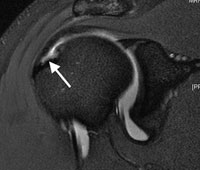
Figure 1. The arrow on this MRI indicates a partial thickness rotator cuff tear. Sometimes these occur in conjunction with other pathology, such as labral tears.

Figure 2. An arthroscopic view shows a partial thickness tear of the supraspinatus.
Images: Center for Shoulder, Elbow and Sports Medicine at Columbia University Medical Center
To complete or not complete
A central decision in treating partial thickness rotator tears is whether to complete the tear, converting it to a full thickness tear or perform a transtendon repair without detaching the intact rotator cuff.
Several concerns are associated with completing the partial tear with subsequent repair. First, the intentionally detached intact tendon increases the overall amount of tissue required for healing and may even increase tension on the repair. In addition, more anchors and suture passing are required to restore the anatomic footprint. In response to this, an arthroscopic in situ or transtendon repair technique has been developed. The transtendon technique requires penetration of the intact bursal side of the rotator cuff to facilitate anchor insertion and suture passing. As long as the bursal side is intact, with a transtendon repair the rotator cuff is preserved, fewer anchors are used and the excision of normal tissue is minimized or avoided entirely, retaining the normal anatomy. The main disadvantage of this procedure is it causes a small amount of damage to the intact tendon for anchor insertion and may retain abnormal tendinotic tissue.
I follow a general treatment guideline despite a lack of strong supporting evidence for this. If 25% of the cuff is torn, rotator cuff debridement is performed. If 50% of the cuff is torn, an in situ all-arthroscopic repair to the footprint is performed without completing the tear. If 75% or more of the cuff is torn, the tear is completed and an all-arthroscopic rotator cuff repair is considered, especially if the intact tendon appears tendinotic.
My surgical technique
I prefer to position the patient in the lateral decubitus position with the shoulder in abduction. Abducting the shoulder with a partial rotator cuff tear brings the tear into the region that is closer to the working portals. Portals include a standard posterior viewing portal, an anterior working portal and a lateral working portal. The anterior working portal is positioned more superior and lateral than typical of other procedures, and this helps facilitate access of instruments, such as shavers and graspers, to the rotator cuff tear.
The procedure begins with the camera introduced into the glenohumeral joint through the posterior portal, and a thorough diagnostic exam is performed prior to creating additional portals (Figure 2). Appreciating the complete pathology, such as combined labral tears, may influence portal placement. Evaluation of the undersurface of the rotator cuff proceeds from anterior to posterior. The arm may be abducted and adducted, and internally and externally rotated as needed. A spinal needle is used to confirm the desired position of the anterior portal. As stated earlier, often the best portal location is more superior and lateral than used in other shoulder arthroscopic procedures.
Next I do some debridement of the tear edges and in the process evaluate the extent of the partial thickness tear by looking at the footprint (Figure 3). Determining the size of the exposed footprint allows calculation of the extent of the partial thickness tear by considering the normal footprint size as between 12 mm and 14 mm.
Bursal side pathology
Performing a bursectomy before placing anchors in a transtendon fashion is essential because subacromial bursa can obscure the suture limbs and compromise knot tying later in the surgery. In addition, the bursal side of the rotator cuff should be inspected for damage which may affect the decision to perform a tear completion. A spinal needle is introduced percutaneously through the tear, and a suture is passed and retrieved out the anterior portal. The suture is then found on the bursal side with the camera in the subacromial space. If there is bursal side damage, its size should be added to the 50% of the footprint rule used on the articular side. The resultant sum will factor into how the tear is best treated.
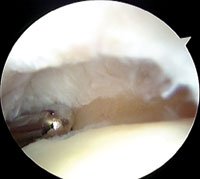
Figure 3. The shaver is shown from the anterior portal. It is used to debride partial thickness tears and debride the insertional footprint.
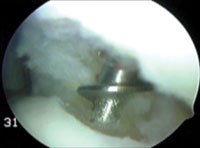
Figure 4. The suture anchor penetrates an intact tendon for placement in the greater tuberosity footprint.
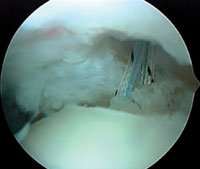
Figure 5. Pictured is a double-loaded suture anchor in place during the procedure in a non-thrower.
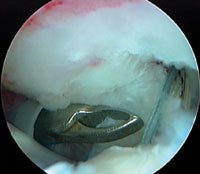
Figure 6. A grasper is used to retrieve a suture limb out the anterior cannula.
Rotator cuff repair steps
A spinal needle is introduced again percutaneously, through the rotator cuff, and to the desired anchor placement location. Adducting the shoulder often helps get a better angle to the medial aspect of the footprint. The anchor is then inserted percutaneously and penetrates the rotator cuff and inserted into the bone (Figure 4). Damage to the rotator cuff during insertion can be minimized if the anchor is screwed in through the soft tissue of the rotator cuff.
After that, anchor placement suture passing is then performed (Figure 5). Several devices may be used, but I prefer a simple 18-gauge spinal needle to minimize trauma to the intact rotator cuff and will shuttle with a monofilament suture. One suture limb from the anchor is retrieved out the anterior working cannula (Figure 6). Working from anterior to posterior, a spinal needle is then used to penetrate the intact bursal cuff and then the articular-sided tear lamina (Figure 7). A monofilament suture is run through the needle and used to shuttle the anchor suture form the anterior cannula through the tear. This is repeated for all sutures of the double-loaded suture anchor (Figure 8). If the tear extends further posterior, additional anchors may be placed and the steps repeated. Tensioning the sutures will demonstrate the reduction of the torn rotator cuff.
The next step is going back into the subacromial space and tying the sutures, which is fairly easy to do having done the bursectomy earlier (Figure 9). The glenohumeral joint is re-visualized once more to inspect the repair (Figure 10).
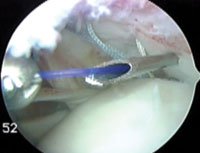
Figure 7. A spinal need penetrates the rotator cuff and a monofilament suture is advanced for suture shuttling.
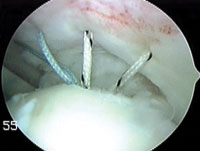
Figure 8. All four sutures are depicted after suture passing is completed.
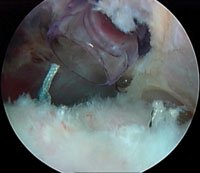
Figure 9. Sutures are tied in the subacromial space, which is much easier to carry out if a bursectomy was initially done.
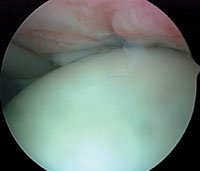
Figure 10. In this final view, the completed repair is seen from the intra-articular space.
Postoperative rehabilitation results
Postoperative rehabilitation following transtendon rotator cuff repair is similar to the standard arthroscopic rotator cuff repair rehabilitation protocol. The arm is placed in a sling with a small pillow. The sling is worn continuously for 4 weeks to 6 weeks, except during bathing and exercises. Active elbow flexion and extension are encouraged for the initial 6 weeks. At the 6-week mark, the program is progressed to active-assisted and active range of motion exercises with progressive stretching. Resistive exercises are added at 10 weeks. Progressive activities are incorporated as strength allows, and unrestricted activities are usually resumed 6 months to 12 months following surgery.
To date, numerous clinical reports support transtendon repair. Biomechanical research also supports transtendon repair. Our group performed a biomechanical study comparing the transtendon technique to the tear completion and repair technique. When subjected to cyclic loading, the transtendon repair had significantly less gapping and higher ultimate failure strength than the tear completion group. Based on clinical reports and biomechanical evidence, we recommend preserving the intact rotator cuff tendon.
References:
- Gonzalez-Lomas G, Kippe MA, Brown GD, et al. In situ transtendon repair outperforms tear completion and repair for partial articular-sided supraspinatus tendon tears. J Shoulder Elbow Surg. 2008;17:722-728. Epub 2008 June 16.
- Ide J, Maeda S, Takagi K. Arthroscopic transtendon repair of partial-thickness articular-side tears of the rotator cuff: Anatomical and clinical study. Am J Sports Med. 2005;33:1672-1679.
- Lo IK, Burkhart SS. Transtendon arthroscopic repair of partial-thickness, articular surface tears of the rotator cuff. Arthroscopy. 2004;20:214-220.
- Seo YJ, Yoo YS, Kim DY, et al. Trans-tendon arthroscopic repair for partial-thickness articular side tears of the rotator cuff. Knee Surg Sports Traumatol Arthrosc. 2011;19:1755-1759.
- Shin SJ. A Comparison of two repair techniques for partial-thickness articular-sided rotator cuff tears. Arthroscopy. 2012; 28(1):25-33. Epub 2011 Oct. 14.
- Snyder SJ. Arthroscopic treatment of partial articular surface tendon avulsions. Presented at the 2001 AAOS/AOSSM Comprehensive Sports Medicine: The athletic perspective to treatment, controversies and problem-solving. Lake Tahoe, Nev.
For more information:
- Christopher S. Ahmad, MD, can be reached at Center for Shoulder, Elbow, and Sports Medicine, Department of Orthopaedic Surgery, Columbia University, 622 W. 168th St., PH-11-Center, New York, NY 10032; 212-305-5561; email: csa4@columbia.edu.
- Disclosure: Ahmad is a paid consultant for Arthrex Inc.
